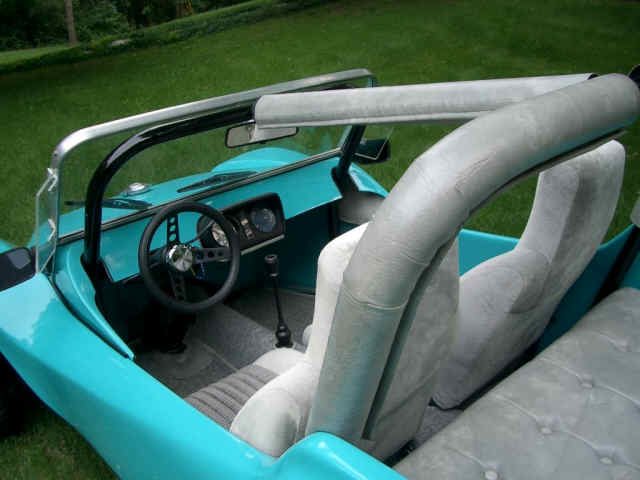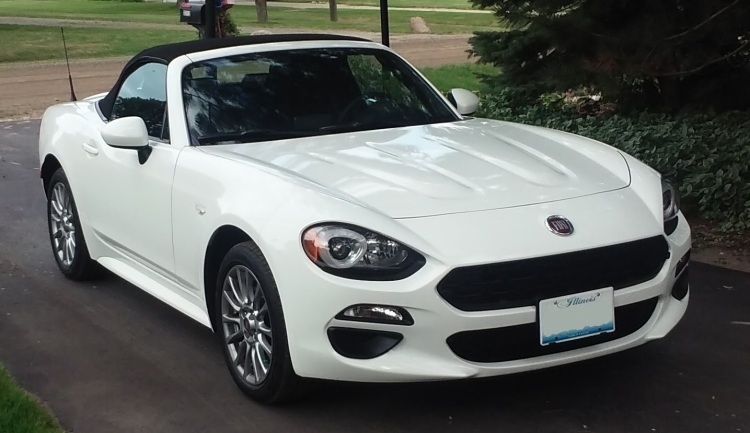
written by Dan Adkins
Thanks to fellow members of the Manx Dune Buggy Club , I went from knowing virtually nothing about my July 2004 purchase of an aqua beach buggy titled as a “1965 VW Roadster” to discovering a treasure trove of historical information that makes for a great story!
Bruce Meyers started the dune buggy industry in 1964 when he designed a fiberglass dune buggy and started producing the Meyers Manx in his tiny shed on the Balboa Peninsula outside Newport Beach. It was a monocoque body with a Beetle engine, transmission and suspension bolted to it and Meyers hoped to sell 20 or 30 (then priced at $985) just to cover the cost of the project. Instead, he would receive more orders than he could fill. Soon thereafter, in order to make the buggies easier to manufacture and more affordable, he redesigned the Manx bodies to bolt onto shortened VW floor pans (with front seats, suspension, beam, wheels, transmission and engine already attached beforehand, if so desired) and when magazines like Hot Rod and Car & Driver featured the fiberglass buggies on their covers, they took the country by storm.
In 1967, after Steve McQueen won his favorite lead role as Thomas Crown in the original production of the United Artists film The Thomas Crown Affair, for which he earned $750,000, and apparently aware of how well the Manx dune buggy performed on the beach, decided he wanted to use a souped-up Manx buggy in the beach racing scenes with co-star Faye Dunaway (who bravely remained seated at his side), rather than a Jeep as the script called for. The film was released on June 18, 1968 and it helped further boost the dune buggy industry, as all of the driving scenes and stunts were done by McQueen himself in the buggy he had customized, known as the Queen Manx (which indeed started out as a Meyers Manx kit purchased from B.F. Meyers & Co.).









these last 4 photos reveal the full restoration



In fact, shortly thereafter, you could order dune buggy bodies produced in ten “groovy” colors – from the SEARS catalog! ⇓

The Thomas Crown buggy is born…
McQueen customized his own version of the Meyers Manx dune buggy design that became known as the Queen Manx, and contracted with Con-Ferr Manufacturing in Burbank, California to modify a Meyers Manx body purchased from B.F. Meyers & Co.
The conversion was finished in eight weeks and included:
● A 4-barrel 140 HP Corvair engine # T0629RB (since the Porsche engine he had originally specified was proclaimed to be too expensive)
● Engine adaptor made by Ted Trevor to mate the swing-axle VW transaxle (with a flipped ring & pinion) to the Corvair engine
● Special extra-wide rear wheels cast by American Racing that were produced to accommodate the Firestone racing tires from Andy Granatelli’s STP Special (#40) turbine car (which almost won the 1967 Indy 500)
● Very unique headlamp scoops that accommodated the smaller 5¾” DOT approved 12-volt headlamps
● Marine-style windshield fabrication and rails
● Custom waffle stitched Naugahyde seats and interior trim by Tony Nancy using Datsun Fairlady seat frames
● Elongated side panels to eliminate the need for side pods; Bruce Meyers never incorporated this feature, since it prevented the bodies from being stackable
● A Con-Ferr nameplate on the hood replacing the Meyers Manx badge
Jon Harting reveals more details [clarified by Dan Adkins, based on feedback from Bruce Meyers]:
I helped build the Queen Manx dune buggy that Steve drove in the Thomas Crown Affair. I worked as a mechanic at Con-Ferr Mfg. Co. from 1967 to 1968. It is gone now, but was at 300 N. Victory Boulevard in Burbank, CA. We manufactured 4-wheel drive accessories and sold new Toyota Land Cruisers with new Chevrolet engines. Somehow we were tasked by Pete Condos, the owner, to build this dune buggy.
I bought a 1966 Corvair engine from a wrecking yard and brought it back to the shop and steam cleaned it. We attached it to a VW transaxle that was in a VW chassis. The body was custom [built modified] in our shop. I remember Steve coming by to look at its progress on two occasions. Both times he drove a red Maserati roadster. He was real nice to all of us there. After the movie came out, we built similar [probably Manx-Vair] dune buggies for Connie Stevens and Dick Smothers. Dick came by every day and watched his being built.
Con-Ferr subsequently produced one or two more Corvair powered replicas of the Queen Manx and, as evidenced in the brochure shown below, they did attempt to market their kits as well, pairing each modified Meyers Manx body with a chassis that was fabricated in-house, rather than with shortened “used” VW floor pans of unknown origin. In fact, Con-Ferr teamed up with B.F. Meyers & Co. in 1968 and produced the chassis for Manx-Vair kits, which had special body modifications to accommodate a complete Corvair rear end (engine, transaxle and suspension) and could be ordered for either Corvair (CC serial numbers) or VW (CV serial numbers) front suspension configurations.

Con-Ferr owner Peter Condos trying out the just completed Queen Manx in the hills of Burbank, California ⇓


… leading to the HUNTER Dune Buggy
The only mass-produced clone of the Thomas Crown buggy
In 1969, Universal Fiberglas in Scarborough, Ontario started producing Hunter Dune Buggy bodies which closely mimicked the Queen Manx design. In fact, the sketch and photos used in the marketing brochure were of the original Queen Manx, even though the end product incorporated an integral dash panel and a Manx-style windshield, rather than the marine-style shown. This allowed the dune buggy to be street-legal by not only accommodating DOT-approved safety glass, but the windshield wiper assembly from the donor car as well.
As with most other fiberglass dune buggy kits of that era, it was assumed that the chassis, power train and most other components would originate from a VW Beetle donor vehicle as well. Since the headlight scoops occupied a good portion of the space normally allocated to the VW fuel tank in the Queen Manx, a special fuel tank was required. The Hunter body mold was designed to create enough room for a Type-1 fuel tank, by moving the headlight mounting surface forward, as well as notching the firewall so that the tank could intrude a few inches into the passenger compartment space behind the dash panel.
My understanding is that only 30 Hunter kits were produced, before moving onto to other better selling VW-based fiberglass kits like the Centurion GT.
In 1993, a gentleman from Sarnia, Ontario rescued the Hunter Dune Buggy that I’ve acquired (then 24-years old) and began restoration by upgrading a VW Beetle Type-1 chassis produced in January 1965 with new floor pans, a new roll-bar cage, a 1971 ball-joint front-end, and a 1971 transmission / IRS rear-end (with 12-volt starter). Then a rebuilt 1971 era 1600 dual-port, dual-relief VW engine with a pair of Type-3 Solex carbs (which fit under the body much better because they are much shorter) was installed.
The dash was reworked such that the radius at both windshield corners were filled in and the holes in the dash panel where switches and instrument gauges had been installed were also filled back in – an instrument cluster pod was then incorporated to neatly replace their function, while still retaining the old-school look.



OVER 50 YEARS OLD!!
I became the proud owner of this rare street-legal buggy in June 2004 and absolutely enjoy driving and tinkering with it. Some items of note that are not of Volkswagen origin:
● 1968 Hillman Hunter nameplate
● 1969 Oldsmobile Cutlass 14″ SS wheels
● 1977 Honda Civic 1200 instrument cluster pod
● 1993 Ford urethane paint – Aqua
● 1971 Chevrolet Vega tail lamps
● 1971 Honda CB750 front signal lamps
● 1991 Chevrolet Cavalier Z-24 seats
● 1969 Dodge Charger flip-up fuel cap
The dune buggy draws a lot of attention, even in the annual Woodward Dream Cruise, since there aren’t many vintage buggies being driven in Michigan, and McQueen’s design modifications like the unique sculpted headlamp scoops really sets it apart from other buggies.
♦♦♦ UPDATES TO MY ORIGINAL ARTICLE ♦♦♦
In preparation for a downsizing move to Illinois, I sold my dune buggy in July 2014 (after 10 years of trouble-free ownership; I think it’s in the Seattle area now) and once we were settled in, I contemplated as to what I would trade my daily driver in for that would give me practical transportation, but also give me the open-air fun factor that I was already missing. After reading an article announcing the new Fiat 124 Spider in the Spring of 2016 and seeing the “Free Like A Bird” video, I liked what I saw and knowing that the interiors were almost identical, I visited a Mazda dealership to sit in a MX-5 and “try it on for size”. Unlike the Pontiac Solstice I had tried out a couple of years before, there was no huge rearward blind spot, and it felt perfect!! After that, my mind was made up, and once the first boatload arrived from Japan, I bought mine.

The guy that bought my buggy has transformed it into a Corvair powered replica of the Queen Manx, and sent me pics ⇓
In 2020, the original Queen Manx finally surfaced and sold at auction for $456,000 US (more details can be found here).





Love info. Do you have more info on the hunter production, colours, coins ? I believe I just found a body in Ontario.
LikeLike
Thanks Will. Just about everything I’d discovered is in the article. A majority of them are in Ontario, as that is where they were manufactured. The only other Hunter body I knew about was also in the Ontario area 10 years ago.
You might enjoy this article.
LikeLike
Where can I find this guy as I’m not far away in BC building my own hunter. Would like to go see this.
LikeLike
I haven’t a clue. Sorry.
LikeLike
Dan,
It’s been a while since we last talked.
Send me an email when you get time. Got a couple questions for you. 🙂
Larry
LikeLike